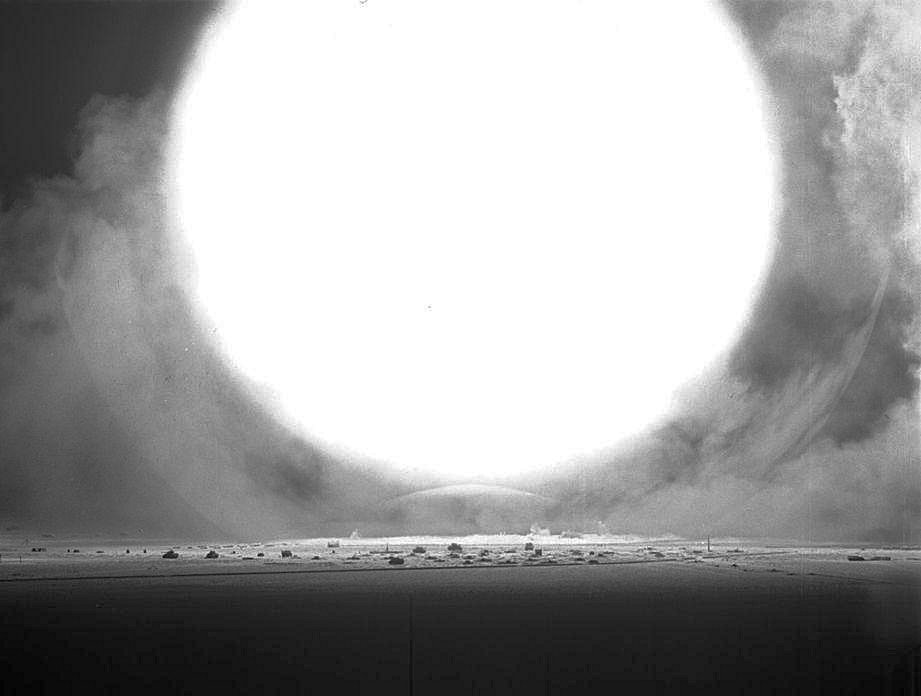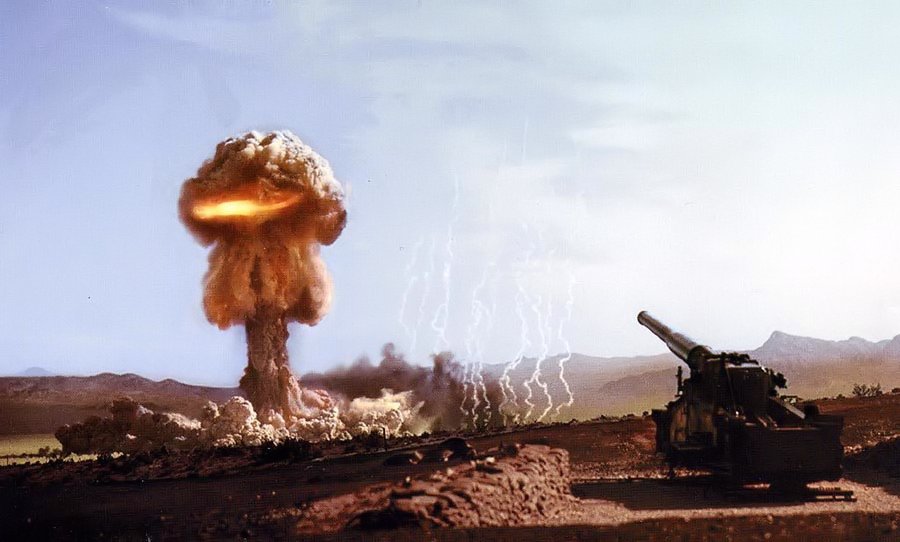Love those nukes... as long as I'm not the target of one!
Here's one of the dumber, "We want nukes, too!", cold war efforts, the M65 atomic cannon. However, this image is very "cool." 15 kilotons in a low airburst.
Sizzle...:
Various info from Wikipedia:
The detonation of Grable occurred 19 seconds after its firing. It detonated over 11,000 yards (over 10 km, 6.25 mi) away from the gun it was fired from, over a part of the Nevada Test Site known as Frenchman Flat. The explosion was an air burst of 160 m (524 ft) above the ground, only 7 m (24 ft) above its designated burst altitude, 26 m (87 ft) west and 41 m (136 ft) south of its target. Its yield was estimated at 15 kilotons, around the same level as Little Boy.
An anomalous feature of the blast was the formation of a precursor, a second shock front ahead of the incident wave. This precursor was formed when the shock wave reflected off the ground and surpassed the incident wave and Mach stem due to a heated ground air layer and the low burst height. It resulted in a lower overpressure, but higher overall dynamic pressure, which inflicted much more damage on drag sensitive targets such as jeeps and personnel carriers. This led strategists to rethink the importance of low air bursts in tactical nuclear warfare.
"The artillery piece could be unlimbered in 15 minutes, then returned to traveling configuration in another 15 minutes." In other words unloaded, reloaded from its transport. What about survey, setup, aiming, and loading time? Undoubtedly classified then and perhaps never released. No matter, the cannon and its crew were blasted to bits by hostile aircraft 10 minutes ago. Air supremacy prevents that? Then
WHY do you need a cannon? That's right, the "me too" effect. Lots of money to spend, obviously no procurement brains to be found. Amazing.
The shell/warhead:
The W9 was an American nuclear artillery shell fired from a special 11 inch howitzer. It was produced starting in 1952 and all were retired by 1957. (Now there's your money's worth. An entire new warhead designed and then shot from the M65 cannon
once until someone finally admitted, "Hey, this thing is
really stupid! Lets get rid of it. Whose idea was this anyway?")
The W9 was 11 inches (280 mm) in diameter, 55 inches (138 cm) long, and weighed 850 pounds (364 kg). It had an explosive yield of 15 kilotons.
The W9 was a gun-type nuclear weapon, using around 50 kilograms of highly enriched uranium in one large rings assembly and one smaller "bullet", which was fired down a tube by conventional explosives into the rings assembly to achieve critical mass and detonate the weapon.
The W9 units which were retired in 1957 were recycled into lower yield T-4 Atomic Demolition Munitions. These were the first (semi) man-portable nuclear weapons.
The W9 is only the second gun-type nuclear weapon known to have been detonated; the first was the Little Boy nuclear weapon used in World War II. The W9 artillery shell was test fired once, in Upshot-Knothole Grable on May 25, 1953. Yield was the expected 15 kilotons.
Subsequently, the W33 nuclear artillery shell was test fired twice during its development. These four detonations are the only identified gun-type bomb detonations.















